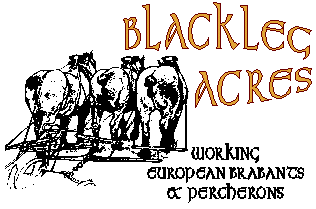
HOME
E-MAIL PICTURES
FOR SALE EVENTS
LINKS
AT STUD HORSE FARMING PROGRAMS & SERVICES
|
AT STUD HORSE FARMING PROGRAMS & SERVICES
|
|
|
WELCOME TO BLACKLEG ACRESWe are a small working farm powered by draft horses. We have two breeds of draft horses here on the farm--European Belgians (Brabants) and Percherons. Our farm is named for our horses, whose coloring of black legs, roan body and massive
build make a truly outstanding horse. We invite you to step back in time
where the only power is horse power. BRABANTS
In Europe, "Belgian" is the generic term applied to several slightly differing breeds of heavy horses. There is the Flemish horse of western Flanders, a region renowned for its heavy horses since the Middle Ages when they were first imported to England and Scotland to improve the local stock. Another slightly lighter type, the Ardennes, comes from the hill country between France and Belgium. No other heavy breed was tougher or would subsist on less. The Brabant is the heaviest of the Belgians and resembles the original type in it's purest form. If any breed of heavy horse can truly be said to have legs like tree trunks, it is surely the Belgian Heavy Draught, which is also known as the Brabancon or the Brabant. The European and American Belgians seem to have little in common apart from name, origin and a shared history up to the middle 1800's, when Americans began importing them. Americans in the 1860's preferred the Brabant type, particularly the sorrel-colored variety which did not have as much appeal to breeders in Belgium who preferred roans, and do up to this day. Brabants in Belgium are present in seven colors: bay, bay-roan, strawberry-roan, blue-roan, black, dapple gray and of course sorrel. The dapple gray color has all but been bred out of the Brabants in Belgium. Only a handful still exist. The contemporary American Belgian is a lighter color than its European ancestors. American breeders continue striving for a taller horse with more action, a horse that could be used in commercial hitches as well as in agriculture--the result was a splendid horse of slimmer lines and plenty of power. PERCHERONS
The Percheron is named after its region of origin, le Perche, a land of rich pastures bordering the valley of the river Huisne in Normandy. The most recognizable feature of the Percheron is its maturing color, a dappled gray that turns white with age. The colors most common in the breed are black and dappled gray, but Percherons can also be bay roan or blue roan. The Percheron's feet show more refinement than those of other breeds. The average height is sixteen to seventeen hands and their weight can be as much as 2,000 pounds. Percherons are known for their friendly disposition. The above information is taken from: Power and Grace--The Working Horse by: Klause Alvermann and Heavy Horses of the World by: Valerie Russell. The American Brabant Association is an organization dedicated to the preservation of the European Belgian and the Brabant type horse. For more information contact: Karen Gruner at THIS SITE WILL BE UPDATED EVERY QUARTER, PLEASE BOOKMARK US IF YOU FIND ANYTHING IN THIS SITE THAT DOES NOT WORK, PLEASE LET ME KNOW
|
|